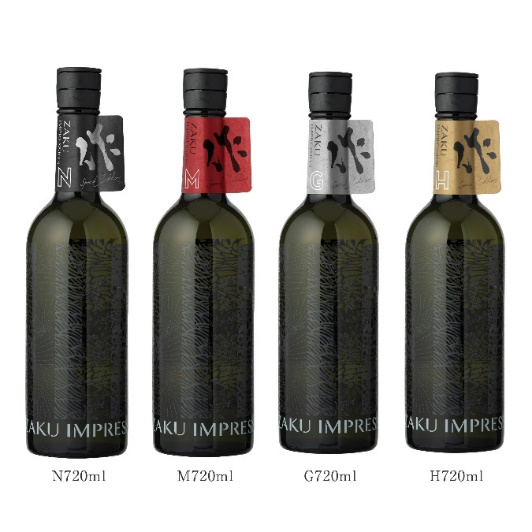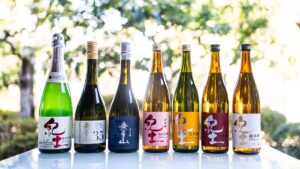
“ZAKU” is brewed in Suzuka city, Mie Prefecture
Contents
Where “ZAKU” came from
Since its establishment, Shimizu Seizaburo Shoten was one of the many sake breweries in the Suzuka area. They used to invite toji (brewers) from Noto, Ishikawa Prefecture and Tanba Sasayama, Kyoto, and brewed a common sake called "Kiyo-musume" every six months. However, due to their advancing age, all the toji retired in 1996.
The incident made them stop and think: “What we currently have is not good enough. We have to make delicious Suzuka sake that can meet the needs of the times”. Subsequent encounters with several great toji in the area motivated them and eventually led to the birth of “ZAKU”.
What they did first in making “ZAKU” was that they asked themselves, "Who decides the value of sake? It's not just the brewer, nor just the sake sellers. Then, the sake sommelier? Is what a restaurant recommends good? No, not always. There are many different types of drinkers, and they drink in different situations. Some drink at parties, some drink in private. In other words, the true value of sake is created not only by the brewer, but also by the people who sell it, recommend it, and drink it.”
“Yes, sake’s value is decided by all those involved.” This was their conclusion.
“To make” is “作る“ in Japanese. So they took the kanji “作” and named their sake after it.
Why then “ZAKU” instead of “SAKU”?

In Japanese, the kanji “作" is read as "saku" in a normal way. The sound is clear.
However, it was decided to write the word in a way more consistent with the pronunciation of the Chinese original, and such that they hoped would be easier to pronounce in foreign countries. So, "ZAKU" was chosen.
On the internet, there is a rumor that "ZAKU" was named after the fictional weapon Zaku*1 in the Gundam animation*2 series, because the president is a big Gundam fan. But this is not true. The president barely knew that character. A plausible story was added after: one of the drinkers happened to be a Gundam fan, and that's how he connected the name Zaku to the sake.
One day, when the president and his wife visited an izakaya (Japanese pub), they happened to be sitting next to a group of people who were drinking "ZAKU" and talking about the Gundam theory.
“We neither denied nor confirmed it. We were impressed and just listened to him telling the story”, says Ms. Shimizu, GM of the brewery.
Such tolerance of the brewer proves the value of “ZAKU” is certainly decided by all those involved.
Note 1: Zaku is a mobile suit that appeared in the "Gundam series" including "Mobile Suit Gundam".
Note 2: The "Mobile Suit Gundam" is a Japanese robot animation series produced by Sunrise Japan. It was aired as an animated television series on Nagoya TV and other stations from 1979.
The “ZAKU” series
No grading shown:
The "ZAKU" regular series includes six types: 1)Miyabi(雅)-no-tomo Nakadori, 2)Miyabi-no-tomo, 3)Kanade(奏)-no-tomo, 4)Megumi(恵)-no-tomo, 5)Ho(穂)-no-tomo, and 6)Gen(玄)-no-tomo.
Unlike most sake brands, the front of the label does not show any gradings such as Jummai Daiginjo, Ginjo, or Jummai (it does on the back of the label). There is a reason. Ms. Shimizu describes, "Many people have a preconception like if it's a Junmai-Daiginjo with a higher price, wouldn't it be good? Or if it’s Jummai, it would be like so and so. We wanted people to make their own choices without being bound by general preconceptions. That’s why we didn’t write general grading on the front”.
Therefore, the drinkers must rely on their senses, when there are no indications for grading. Each kanji may help tasting with its image:
雅(miyabi) meaning refinement, graceful, 奏(kanade) meaning play or perform, 恵(Megumi) meaning blessing, wisdom or enlightenment, 穂(ho) meaning ear of the crops and 玄(gen) gives you an image of brown rice.
No retail price:
I was also surprised to hear that Shimizu Seizaburou Shoten didn't even set the retail price in the first place.
This was based on the idea that, just like vegetables, once they are out of the hands of the people who produced them, they should be sold at a value set by the people who sell, manage, supply, and provide them. Unsurprisingly, retailers said, "We can't accept that. Please set the retail price," and the brewery obliged .
"Just like vegetables?” What a unique idea!
The highest grade of "ZAKU": "Take-Zaku(筰)"

筰(Takezaku) was born as a response to the question, "What is the best sake?”
It is made by packing the mash (moromi) in a bag during the cold winter months and collecting the flowing drops drop by drop into a funnel (tobin).
In this tobin enclosure process, multiple tobins are filled with drops, and the collected drops of sake in each tobin has a slightly different taste.
The best quality that the Toji feels is the best becomes 筰(Takezaku). Only a small quantity is obtained.
In kanji 筰(Takezaku), you will notice there is a “bamboo radical” on top of “ZAKU (作)”. It is a crown symbolizing the top of "ZAKU".
The "ZAKU" IMPRESSION Series

The “ZAKU” IMPRESSION series is one of the hardest sake to find in liquor shops, because the shipment quantity is limited as they are very sensitive to the shipping environment.
“Freshly collected or squeezed sake without pasteurization (nama-zake:生酒) tastes the best,” says Ms. Shimizu.
However, Shimizu Seizaburo Shoten does not make nama-zake. Nama-zake does not undergo pasteurization to keep its freshness, but consequently there is a risk of deterioration during shipping. Shimizu Seizaburo Shoten didn’t want to take that risk.
Instead, they went through much trial and error to find a way to ship sake with a taste similar to that of unpasteurized sake, and that was the beginning of the IMPRESSION series.
A prototype was first released with a name as it is, "PROTOTYPE", only delivered to those dealers who were willing to buy it. Gradually, they succeeded to make a stable quality sake, and changed the name from “PROTOTYPE” to “IMPRESSION” hoping the series would impress people who drank it.
Even though it has been pasteurized, it is as close to nama-zake as possible. You can even feel a slight fizz.
Particular about bottle

The bottles of the IMPRESSION series are engraved with Ise-katagami patterns*3.
In the Edo period, there was a time when luxury was not allowed. The patterns used for kimonos and other accessories could never be flashy. Therefore, fashionable men and women began to compete in how elaborate small items could be.
Ise-katagami patterns, which are hand-carved by craftsmen, became particularly popular among them. The beauty of the delicate and unique texture of the patterns is breathtaking. Suzuka was the center of the industry.
However, as time went by, the Japanese kimono fashion dwindled away and the number of Ise-katagami craftsmen in Suzuka decreased drastically. Under such circumstances, Shimizu Seizaburo Shoten adopted it for sake bottles in order to carry on the culture of Suzuka.
The engraved bottle is fascinating. Even in overseas sake fairs, Shimizu Seizaburou Shoten has nothing to worry about how to discard the bottles, because they are all taken away by dedicated fans.
"The beauty of Ise-katagami can also be seen in the labels of "Suzukagawa," another series handled by Shmizu Seizaburo Shoten.

Note 3: Ise-katagami is a type of stencil used to dye fabrics such as kimonos with a certain pattern or design. The stencils are not only used for dyeing, but also for arts and crafts, furniture, etc. It is mainly produced in Suzuka City, Mie Prefecture, and more than 90% of the Ise-katagami in circulation today is produced in this area.
Particular about font

Suzuka is not only a producer of Ise-katagami, but also a producer of sumi ink. In Japan, only Nara and Suzuka produce sumi ink, and Suzuka is the only place where the entire process is done by one person.
Using the locally processed Suzuka ink, the font of “ZAKU” released on October 1, 2021 was written by Mr. Koji Hasegawa, Chairman of the Nihon Shokyo-in*4. The “Suzuka” essence is concentrated in both the label and the bottle.
Note 4: Nihon Shokyo-in (日本書鏡院) is a calligraphy organization founded by Konan Hasegawa in 1933. They keep passing on six writing styles that have been handed down in Japan since ancient times.
About Shimizu Seizaburo Shoten, Ltd.

The brewery was founded in 1869. The name of the brewery was Daikokuya Shimizu Seizaburo Shoten, named after the founder, Shimizu Seizaburo. The head of the family kept the name until the fourth generation. The current president is Shimizu Shinichiro, the 6th generation.
When the company was incorporated in 1952, the name was changed to Shimizu Brewing Company, but again changed back to its original and familiar name of Shimizu Seizaburo Shoten in 2012. That year was a turning point for the company.
The year 2012 marked the 60th anniversary of the company's establishment. It was also the year Suzuka City celebrated its 70th anniversary. Therefore, the municipal government asked them to make a Suzuka sake using Ise-katagami as a souvenir for the celebration. This was the beginning of “ZAKU”.
Since then, “ZAKU” has achieved remarkable breakthroughs, especially when it was used for a toast in the 42nd G7 Summit in 2016. Now, it has an established world reputation.

The year 2019 would have been the 150th anniversary of the company, but all celebrations were cancelled due to COVID. “We couldn't invite people, and we couldn't go out. So, we decided to sit back and focus on renovating the company building”, says Ms. Shimizu. The Shimizu Seizaburou Shoten will be reborn in 2022.
Incidentally, the "ZAKU" series, released in October 2021, was redesigned. And the quantity increased up to 750ml per bottle without raising the price. This is also representative of the president's intention to "cheer up the depressed society” in the time of COVID-19.
I can’t wait for the new “ZAKU”.
Interview cooperated by: Ms. Masae Shimizu, General Manager, Shimizu Seizaburo Shoten, Ltd.
Date of interview: September 17, 2021
Image data presented by: Shimizu Seizaburo Shoten, Ltd.
Post-interview: Interview was conducted online. The more I knew about “ZAKU”, the more I became a fan. I wish for those who share this post to enjoy “ZAKU” from various angles.
During the interview, I was impressed by the background of the ZOOM window. Ms. Shimizu responded to the interview from a very quaint and spacious Japanese-style room.


